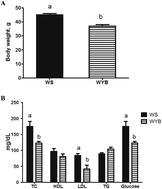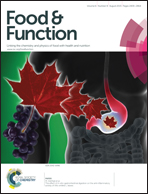Yeast with bacteriocin from ruminal bacteria enhances glucose utilization, reduces ectopic fat accumulation, and alters cecal microbiota in dietary-induced obese mice
Abstract
Background: This study investigated the effect of yeast with bacteriocin (YB) on the homeostasis of lipid and glucose in diet-induced obese (DIO) mice. Seven-week-old C57BL/6 male mice were fed with a Western diet for 24 weeks to induce obesity. These DIO mice were randomly assigned to 2 groups: obese control (WS) and WYB [0.125 μg YB per g body weight (BW)]. YB was administered daily to the WYB mice in the last 4 weeks, while an equal volume of normal saline was administered to the WS mice. Results: YB caused a significant reduction in BW, and in plasma levels of total cholesterol and glucose. Less hepatic lipid accumulation and smaller adipocytes were observed in WYB mice. WYB mice had higher lipid catabolism in liver and adipose tissue. Compared with WS mice, WYB mice had higher glycolysis in the liver and muscles. YB suppressed hepatic GLUT5 expression, altered the composition of cecal microbiota, and also caused more efficient carbohydrate utilization for energy expenditure. Conclusion: YB resulted in body weight loss, promoted lipid catabolism and carbohydrate utilization; it also modulated cecal microbiota, and therefore partially improved the health of obese mice.


 Please wait while we load your content...
Please wait while we load your content...